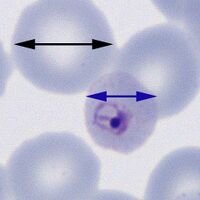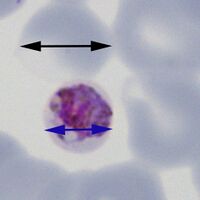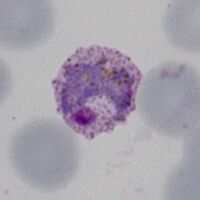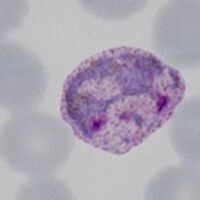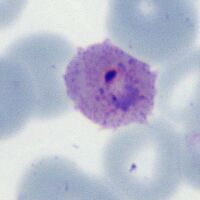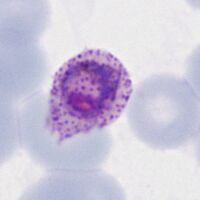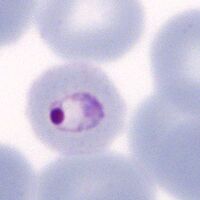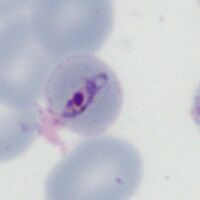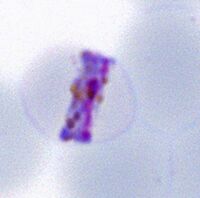Red cell size: Difference between revisions
From haematologyetc.co.uk
No edit summary |
No edit summary |
||
| Line 19: | Line 19: | ||
</gallery> | </gallery> | ||
The early and late trophozoites shown in this image | The early (A) and late trophozoites (B) shown in this image each lie within round erythrocytes with reduced size. | ||
---- | ---- | ||
Revision as of 19:13, 24 March 2024
Navigation
Go Back
| How is red cell size and shape affected as malaria develops?
During parasite develop,emt each species alters the red cell that they occupy. These changes differ between species causing characteristic changes to.red. cell size and red cell shape. These changes occur from a relatively early stage of parasite development although the very earliest trophozoites may yet show these features P.malariae: The red cells in this species remain round and are often small in size The early (A) and late trophozoites (B) shown in this image each lie within round erythrocytes with reduced size. P.vivax The trophozoites are usually present at all developmental stages, during parasite development they become solid and irregular developing an increasingly amoeboid appearance. During this development the red cells become markedly enlarged and distorted, with characteristic Schüffner's dots. P.ovale The rings are larger and more robust than in P.falciparun, and they enlarge further during parasite development although in this species the characteristic ring appearance can often still be distinguished even late in development. Note that red cells become enlarged and distorted (typically elongation and fimbriation) with characteristic James' dots. P.malariae The rings are small but generally appear more robust than P.falciparum, the parasites become more solid often losing the central digestive vacuole and may become angular or extend as a band across the cells. Red cells are not enlarged or distorted and are often reduced in size as they mature in this species
these changes are. illustrated for. early and. late trophozoite below early trophozoites fsmall or normal p..emalariae round p..efalciparum round normal or. enlarged p..eovale may. become ovoid generally enlarged p..evivax may. become irregular late trophozoites file msi2.ejpg.
|
